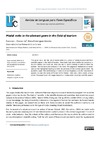Identificador persistente para citar o vincular este elemento:
https://accedacris.ulpgc.es/jspui/handle/10553/56373
| Campo DC | Valor | idioma |
|---|---|---|
| dc.contributor.author | Alvarez Gil, Francisco J. | en_US |
| dc.contributor.author | Domínguez Morales, María Elena | en_US |
| dc.date.accessioned | 2019-08-27T11:06:07Z | - |
| dc.date.available | 2019-08-27T11:06:07Z | - |
| dc.date.issued | 2018 | en_US |
| dc.identifier.issn | 1133-1127 | en_US |
| dc.identifier.other | Dialnet | - |
| dc.identifier.uri | https://accedacris.ulpgc.es/handle/10553/56373 | - |
| dc.description.abstract | This paper looks into the use of modal verbs in a corpus of abstracts excerpted from scientific papers in the field of tourism. These texts have been written by specialists in tourism studies. Our study will show the way in which modality is used to show the authors’ intention as to the contents of their texts. The pragmatic implications of modal uses will be highlighted bearing in mind the purposes of the abstract genre within the academic paper. The methodology of study is corpus linguistics, and the framework of analysis includes the works of Palmer (1979; Palmer, 1986) and Collins (2009), among others. This paper is part of a larger research on modal verbs in touristic scientific papers. | en_US |
| dc.language | eng | en_US |
| dc.relation.ispartof | LFE. Revista de Lenguas para Fines Específicos | en_US |
| dc.source | LFE: Revista de lenguas para fines específicos [ISSN 1133-1127], v. 24 (2), p. 27-37 | en_US |
| dc.subject | 570111 Enseñanza de lenguas | en_US |
| dc.subject | 570107 Lengua y literatura | en_US |
| dc.subject | 550510 Filología | en_US |
| dc.subject.other | Modal verbs | en_US |
| dc.subject.other | Modality | en_US |
| dc.subject.other | Mitigation | en_US |
| dc.subject.other | English | en_US |
| dc.subject.other | Tourism | en_US |
| dc.title | Modal verbs in the abstract genre in the field of tourism | en_US |
| dc.type | info:eu-repo/semantics/Article | en_US |
| dc.type | Article | en_US |
| dc.identifier.doi | 10.20420/rlfe.2018.232 | |
| dc.identifier.isi | 000456420600002 | |
| dc.identifier.url | http://dialnet.unirioja.es/servlet/articulo?codigo=6881742 | - |
| dc.description.lastpage | 37 | - |
| dc.identifier.issue | 2 | - |
| dc.description.firstpage | 27 | - |
| dc.relation.volume | 24 | - |
| dc.investigacion | Artes y Humanidades | en_US |
| dc.type2 | Artículo | en_US |
| dc.contributor.daisngid | 10346492 | |
| dc.contributor.daisngid | 29507241 | |
| dc.contributor.authordialnetid | 4278810 | - |
| dc.contributor.authordialnetid | No ID | - |
| dc.identifier.dialnet | 6881742ARTREV | - |
| dc.utils.revision | Sí | en_US |
| dc.contributor.wosstandard | WOS:Alvarez-Gil, FJ | |
| dc.contributor.wosstandard | WOS:Dominguez-Morales, E | |
| dc.date.coverdate | 2018 | |
| dc.identifier.ulpgc | Sí | es |
| dc.description.esci | ESCI | |
| dc.description.dialnetimpact | 0,0 | |
| dc.description.dialnetq | Q1 | |
| dc.description.dialnetd | D2 | |
| dc.description.erihplus | ERIH PLUS | |
| item.fulltext | Con texto completo | - |
| item.grantfulltext | open | - |
| crisitem.author.dept | GIR Discourse, Communication and Society | - |
| crisitem.author.dept | Departamento de Filología Moderna, Traducción e Interpretación | - |
| crisitem.author.dept | GIR Discourse, Communication and Society | - |
| crisitem.author.dept | Departamento de Filología Moderna, Traducción e Interpretación | - |
| crisitem.author.orcid | 0000-0002-8752-9091 | - |
| crisitem.author.orcid | 0000-0002-0576-6772 | - |
| crisitem.author.parentorg | Departamento de Filología Moderna, Traducción e Interpretación | - |
| crisitem.author.parentorg | Departamento de Filología Moderna, Traducción e Interpretación | - |
| crisitem.author.fullName | Álvarez Gil, Francisco José | - |
| crisitem.author.fullName | Domínguez Morales, María Elena | - |
| Colección: | Artículos | |
Citas de WEB OF SCIENCETM
Citations
1
actualizado el 12-ene-2026
Visitas
286
actualizado el 16-ene-2026
Descargas
191
actualizado el 16-ene-2026
Google ScholarTM
Verifica
Altmetric
Comparte
Exporta metadatos
Los elementos en ULPGC accedaCRIS están protegidos por derechos de autor con todos los derechos reservados, a menos que se indique lo contrario.
